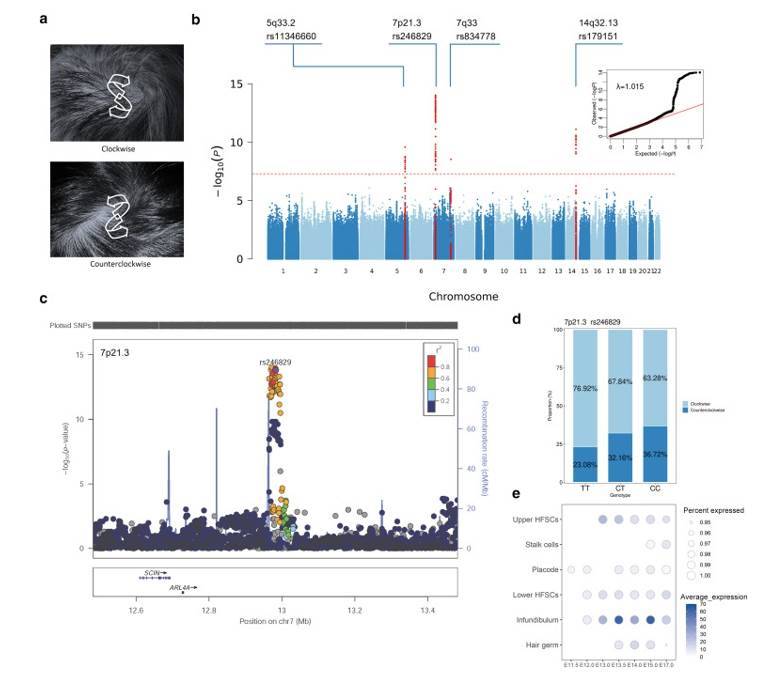As an easily observable human characteristic, the formation of hair whorl is established during the 10-16 weeks of gestation. These whorls are characterized by both the number of coils (either single or double) and their directional orientation (such as clockwise, counterclockwise, or diffuse). Research has revealed that a single gene governs the inheritance of hair spiral patterns, adhering to Mendelian genetics. Thus, the appearance of your hair whorl is primarily determined by your parental genetic makeup, and it has no bearing on your personality or destiny. Moreover, scientific investigations have identified atypical spiral patterns in individuals with neurodevelopmental anomalies, underscoring the potential significance of understanding the genetic underpinnings of these patterns in unveiling crucial biological processes.
In a comprehensive study, researchers conducted a genome-wide association study (GWAS) involving 2,149 participants from the Chinese Physical Characteristics Survey cohort. Subsequently, the GWAS findings were corroborated by examining 1,950 individuals from the Taizhou Longitudinal Study cohort. This collaborative effort led to the identification of four specific genetic variants (located at 7p21.3, 5q33.2, 7q33, and 14q32.13). These findings suggest that the orientation of hair whorl is influenced by the cumulative impact of multiple genes, signifying polygenic inheritance. This study also shed light on the role of these genetic variants in regulating the polarity of hair follicle cells, potentially influencing the closure and growth of the cranial neural tube.
The research endeavor encompassed a comprehensive analysis involving 2,149 individuals, alongside a replication validation cohort consisting of 1,950 participants, all of whom willingly provided written informed consent. The scope of this Genome-Wide Association Study (GWAS) was constrained to individuals exhibiting a solitary clockwise or counterclockwise hair spiral orientation, due to the limited availability of sample sizes for other spiral patterns. This restriction resulted in reduced statistical power for the GWAS. Initially, the distribution of helix orientations within this study population closely aligned with prior research findings, exhibiting no notable distinctions between genders.
Utilizing linear mixed modeling techniques, the researchers pinpointed a genetic locus located at 7p21.3, which was subsequently corroborated in the TAY longitudinal study cohort. Further amalgamating the data from both cohorts, the researchers unearthed three additional significant genetic signals at positions 5q33.2, 7q33, and 14q32.13.
The research team then embarked on the task of identifying potential causal variants for each signal through functional annotation, with a focus on prioritizing candidate genes. This process entailed a comprehensive analysis of the annotation results and associated scores to propose candidate variants that may possess biological significance. Notably, for the most prominent signal at 7p21.3, the putative causal variant, rs246829, was situated 252 kb downstream of ARL4A, a known quantitative trait locus for ARL4A expression within the skin. Additionally, rs246829 was found to be nestled within a set of transcription factor binding sites, indicating its role as a gene regulatory region. Consequently, it was postulated that rs246829 could potentially influence the direction of hair spin by modulating ARL4A expression within the skin. Furthermore, individuals carrying the risk allele 'C' exhibited an elevated likelihood of counterclockwise hair rotation.
 GWASs of hair whorl direction identified four significant signals.
GWASs of hair whorl direction identified four significant signals.
Intriguingly, in an examination of single-cell sequencing data obtained from mouse embryo hair follicles spanning the developmental range from day 11.5 to 17.0, the researchers discerned that ARL4A exhibited peak expression levels during the same developmental timeframe when the angle of cell division crucially contributes to hair follicle epithelial cell development. The overall orientation of hair follicles during mouse embryogenesis is guided by planar cell polarity mechanisms. Consequently, the researchers posited that ARL4A plays a pivotal role in shaping keratinocytes during early skin and hair follicle development, chiefly by modulating the actin cytoskeleton and integrating the planar cell polarity pathway. This intricate process ultimately culminates in alterations in follicle orientation and, consequently, shifts in the helical orientation of hair strands.
The integrative analysis has revealed significant signals at 14q32 and 5q33.2, which are closely associated with protein-coding genes in their vicinity. Notably, the potential single nucleotide variant (SNV) loci, specifically 14q32.13 and rs179151, represent expression quantitative trait loci (eQTLs) situated within the SYNE3 gene promoter. These eQTLs exert an influence on actin cytoskeletal interactions and play a crucial role in cell polarity and cortical development.
Furthermore, the putative causal variable, rs11346660, resides within an enhancer region of HAND1, a basic helix-loop-helix transcription factor essential for craniofacial morphogenesis. In contrast to ARL4A genes, SYNE3 and HAND1 genes exhibit reduced expression levels during hair follicle development. Given that hair follicles emerge at the site of cranial neural tube closure, it is plausible that SYNE3 and HAND1 impact craniofacial development, potentially influencing scalp hair alignment and directionality, rather than having a direct effect on skin development.
While prior research has hinted at a potential link between hair rotation patterns and neurological disorders, this study's Genome-Wide Association Analysis (GWAS) failed to establish such a connection. Nevertheless, this investigation successfully shed light on the relationship between HAND1 gene variations and male pattern hair loss, even though the precise biological mechanism underlying this pleiotropy remains enigmatic.
In essence, this study unveiled hair rotation direction as a polygenic trait and pinpointed four gene loci associated with it. The functions of these genes suggest their involvement in cell polarity and cytoskeletal structure regulation during hair follicle development, as well as in the closure and growth of the cranial neural tube. These processes, in turn, may influence the orientation of hair follicles and correlate with the direction of hair spin. Remarkably, this study marks the pioneering effort in genetically localizing human scalp hair rotation, affirming not only its genetic underpinnings but also its multifaceted regulation by multiple genes.
Reference:
-
Luo, Junyu, et al. "GWASs Identify Genetic Loci Associated with Human Scalp Hair Whorl Direction." The Journal of investigative dermatology (2023): S0022-202X.
For research purposes only, not intended for clinical diagnosis, treatment, or individual health assessments.


 Sample Submission Guidelines
Sample Submission Guidelines
 GWASs of hair whorl direction identified four significant signals.
GWASs of hair whorl direction identified four significant signals.